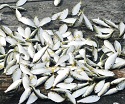 The fishing industry hailed a decision by the Atlantic States Marine Fisheries Commission last week to increase the allowable catch numbers for menhaden, an oily forage fish in the Chesapeake Bay. The commission increased by 10 percent the total allowable catch for the 2015 and 2016 fishing seasons after a recent assessment indicated the species “is not overfished or experiencing overfishing relative to the current biological reference points.”
The fishing industry hailed a decision by the Atlantic States Marine Fisheries Commission last week to increase the allowable catch numbers for menhaden, an oily forage fish in the Chesapeake Bay. The commission increased by 10 percent the total allowable catch for the 2015 and 2016 fishing seasons after a recent assessment indicated the species “is not overfished or experiencing overfishing relative to the current biological reference points.”
Released in February, the upbeat assessment seemed to support the fishing industry’s objections to catch limits imposed at the end of 2012 following an assessment that indicated overfishing. The commission, which regulates catches along the East Coast, imposed a 20 percent harvest reduction for the first time that year.
The Menhaden Fisheries Coalition, which represents more than 90 percent of menhaden fishermen and related businesses along the Atlantic coast, praised the latest assessment as “the most accurate menhaden assessment in recorded history” in a press release, calling out environmental groups that supported harvest reductions based on earlier data.

The commission acknowledged in February that this latest assessment provides a much clearer analysis of the current state of the menhaden stock than previous data, which relied heavily on commercial fishing reporting. The new assessment made use of information from federal and state agencies and organizations as well as fishermen, and a peer review panel found it to be thorough and comprehensive.
Even with the long awaited catch quotas set and the latest data released, the fishing industry and conservation groups still have disparate takes on what’s best for both the species and the industry that is built around it.
Some environmental groups say the latest data still doesn’t consider enough factors, such as the impact of menhaden fishing on species that rely on the feeder fish. They cite reduced populations and health of rockfish or striped bass as evidence of the menhaden fishing industry’s long-term environmental impacts.
The Chesapeake Bay Ecological Foundation, for example, disagreed with the conclusions of the ASMFC’s most recent stock assessment and its finding that the menhaden had not been overfished for decades. The foundation agrees with other environmental groups that assessing only the menhaden’s population oversimplifies the key role of the species as a staple food for other fish in the Chesapeake Bay ecosystem.
Conversely, the Fisheries Coalition and like-minded groups said that the industry should not be subject to restrictions based on assumptions about the fish’s ecosystem role.
“These estimates have undergone peer review and approval and are thus still the best information available on menhaden’s interactions with predators,” the coalition said in a press release.
The ASMFC said it tried to strike a balance between these two forces when it released this latest assessment and the catch allowance. In a statement by Board Chair Robert Boyles from South Carolina it acknowledged its commitment to “fully evaluate the ecological role of Atlantic menhaden” as it continues to hone its assessments process.
Menhaden make up the largest harvest in the Bay when measured by pounds. They are harvested by a large fishery based in Virginia run by Omega Protein that accounts for a little more than three-quarters of the coastal harvest. Omega turns the fish, high in Omega-3 fatty acids, into a variety of products such as vitamin supplements and pet foods. There is also a commercial fishery that catches menhaden to be used for bait.
In a press release issued just after the new catch allowances were announced, Omega praised the changed assessment. The company said that improvements in the fish’s population had everything to do with improvements in data collection and little to do with the harvest restrictions of 2012, which, “yielded economic hardship and job losses in many fishing communities.”
The ASMFC set the 2015 quota for Atlantic menhaden for Virginia alone at almost 350 million pounds. These quotas might be adjusted pending final 2014 landings.
The ASMFC board also said it will convene a working group to aid in the development of its future assessments, which will collect public comments on the subject later this year.
Read more about what led to the changed assessment in our March issue or here.
